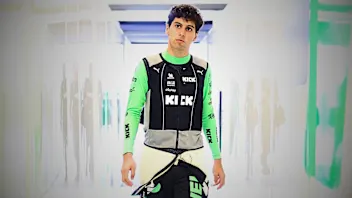Closer racing and more overtaking – these were the key targets as rule changes for the 2019 season were announced. In a video produced by our tech team of Giorgio Piola and Mark Hughes, we explain the major revisions aimed at spicing up the racing in 2019…
Unity amongst all parties is not always forthcoming in a sport as competitive as Formula 1, but when it comes to future regulations, everyone from the fans, to the FIA, to F1, to the teams and drivers is united in a belief that delivering closer competition and more passing must be priorities.
These considerations are a key factor as the FIA, in collaboration with a Pat Symonds-led aero team at F1, continue work on shaping the technical regulations for 2021. But we don’t have to wait another three years to see the first fruits of that research. In fact, the initial developments will arrive much sooner, with a number of significant aero changes being introduced next season to spice up the racing.
These are shown in detail in the video above, but in summary the changes are:
-
A simplified front wing with standardised endplates, tweaked dimensions and no upper flaps. This will encourage aerodynamicists to direct more of the flow to the underbody (where it is less sensitive to the disturbed wake of the car in front) than the outer body
-
The deletion of the upper flaps at the outer ends of the wing will make it impossible to create the vortices that are generated by the current, highly complex endplates to enhance the outer-body aerodynamics. This will further encourage the so-called ‘inwash’ aero philosophy of directing airflow to the underbody, rather than the current emphasis on ‘outwash,’ which is highly sensitive to the air from the car ahead and therefore makes it harder for cars to follow one another closely
-
Tweaks to the front wing’s dimensions and the limiting of under-wing strakes to two each side to further discourage outwash aerodynamics
-
Winglets mounted on the brake ducts currently play a part in directing the flow to the outer part of the body. These are banned from 2019, as are blown axles, which currently use air directed out of the centre of the wheel at high speed to energise the flow down the outer surfaces of the bodywork further back
-
Barge boards are lowered by 150mm (to make them less powerful in directing the airflow) and moved forwards by 100mm to make them less sensitive to the airflow being disturbed from the car in front
-
The rear wing endplates will no longer be permitted to have horizontal gills. These equalize the pressure between the inner and outer faces of the endplate to give a faster flow over the top of the wing for more downforce, but they introduce an extra disturbance to the wake, which worsens the performance of the car behind
-
The DRS opening will be increased from 65mm to 85mm. Together with an increase in width and height of the wing, this will make the DRS around 25-30% more powerful so as to allow it to be effective on those circuits with too short a straight for the current system. The FIA will also review the length of DRS zones at every circuit in order to maximise the effect of the changes
-
The increased height of the wing will take the 'rooster tail' wake coming off the back of it higher into the air than currently. More of the energy from that wake will be diffused into the free air around it before it returns to the level where it will be affecting the following car
Next Up
Related Articles
 ExclusiveBortoleto on his rookie year and Audi excitement
ExclusiveBortoleto on his rookie year and Audi excitement Who are the 2026 F1 drivers?
Who are the 2026 F1 drivers? Mekies on ‘very difficult’ decision to demote Tsunoda
Mekies on ‘very difficult’ decision to demote Tsunoda.webp) End Of Year Reports 2025Ferrari’s best and worst moments from 2025
End Of Year Reports 2025Ferrari’s best and worst moments from 2025 Best radio and more – F1's 2025 alternative awards
Best radio and more – F1's 2025 alternative awards /TEAM%20PREVIEWSHALF%20TERM%20REPORTS%20DISPLAY%20V1%20(13).webp) End Of Year Reports 2025Racing Bulls’ best and worst moments from 2025
End Of Year Reports 2025Racing Bulls’ best and worst moments from 2025